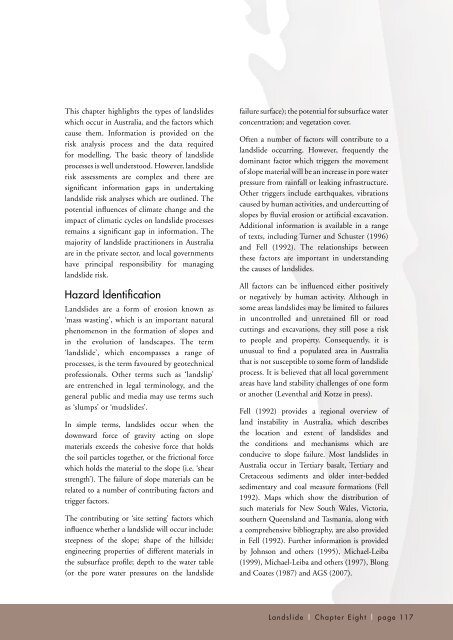Landslide - Geoscience Australia
Landslide - Geoscience Australia
Landslide - Geoscience Australia
You also want an ePaper? Increase the reach of your titles
YUMPU automatically turns print PDFs into web optimized ePapers that Google loves.
This chapter highlights the types of landslides<br />
which occur in <strong>Australia</strong>, and the factors which<br />
cause them. Information is provided on the<br />
risk analysis process and the data required<br />
for modelling. The basic theory of landslide<br />
processes is well understood. However, landslide<br />
risk assessments are complex and there are<br />
significant information gaps in undertaking<br />
landslide risk analyses which are outlined. The<br />
potential influences of climate change and the<br />
impact of climatic cycles on landslide processes<br />
remains a significant gap in information. The<br />
majority of landslide practitioners in <strong>Australia</strong><br />
are in the private sector, and local governments<br />
have principal responsibility for managing<br />
landslide risk.<br />
Hazard Identification<br />
<strong>Landslide</strong>s are a form of erosion known as<br />
‘mass wasting’, which is an important natural<br />
phenomenon in the formation of slopes and<br />
in the evolution of landscapes. The term<br />
‘landslide’, which encompasses a range of<br />
processes, is the term favoured by geotechnical<br />
professionals. Other terms such as ‘landslip’<br />
are entrenched in legal terminology, and the<br />
general public and media may use terms such<br />
as ‘slumps’ or ‘mudslides’.<br />
In simple terms, landslides occur when the<br />
downward force of gravity acting on slope<br />
materials exceeds the cohesive force that holds<br />
the soil particles together, or the frictional force<br />
which holds the material to the slope (i.e. ‘shear<br />
strength’). The failure of slope materials can be<br />
related to a number of contributing factors and<br />
trigger factors.<br />
The contributing or ‘site setting’ factors which<br />
influence whether a landslide will occur include:<br />
steepness of the slope; shape of the hillside;<br />
engineering properties of different materials in<br />
the subsurface profile; depth to the water table<br />
(or the pore water pressures on the landslide<br />
failure surface); the potential for subsurface water<br />
concentration; and vegetation cover.<br />
Often a number of factors will contribute to a<br />
landslide occurring. However, frequently the<br />
dominant factor which triggers the movement<br />
of slope material will be an increase in pore water<br />
pressure from rainfall or leaking infrastructure.<br />
Other triggers include earthquakes, vibrations<br />
caused by human activities, and undercutting of<br />
slopes by fluvial erosion or artificial excavation.<br />
Additional information is available in a range<br />
of texts, including Turner and Schuster (1996)<br />
and Fell (1992). The relationships between<br />
these factors are important in understanding<br />
the causes of landslides.<br />
All factors can be influenced either positively<br />
or negatively by human activity. Although in<br />
some areas landslides may be limited to failures<br />
in uncontrolled and unretained fill or road<br />
cuttings and excavations, they still pose a risk<br />
to people and property. Consequently, it is<br />
unusual to find a populated area in <strong>Australia</strong><br />
that is not susceptible to some form of landslide<br />
process. It is believed that all local government<br />
areas have land stability challenges of one form<br />
or another (Leventhal and Kotze in press).<br />
Fell (1992) provides a regional overview of<br />
land instability in <strong>Australia</strong>, which describes<br />
the location and extent of landslides and<br />
the conditions and mechanisms which are<br />
conducive to slope failure. Most landslides in<br />
<strong>Australia</strong> occur in Tertiary basalt, Tertiary and<br />
Cretaceous sediments and older inter-bedded<br />
sedimentary and coal measure formations (Fell<br />
1992). Maps which show the distribution of<br />
such materials for New South Wales, Victoria,<br />
southern Queensland and Tasmania, along with<br />
a comprehensive bibliography, are also provided<br />
in Fell (1992). Further information is provided<br />
by Johnson and others (1995), Michael-Leiba<br />
(1999), Michael-Leiba and others (1997), Blong<br />
and Coates (1987) and AGS (2007).<br />
<strong>Landslide</strong> | Chapter Eight | page 117

















